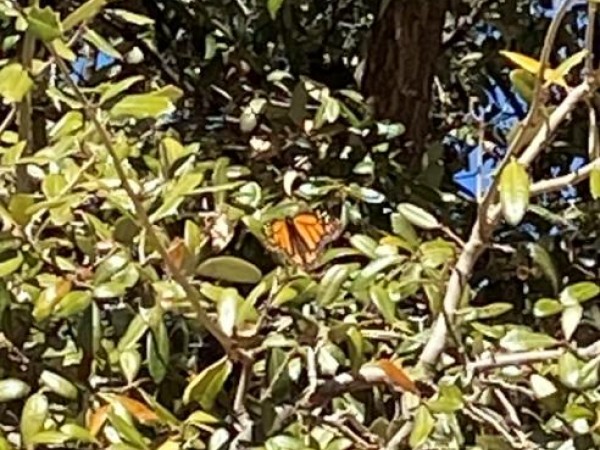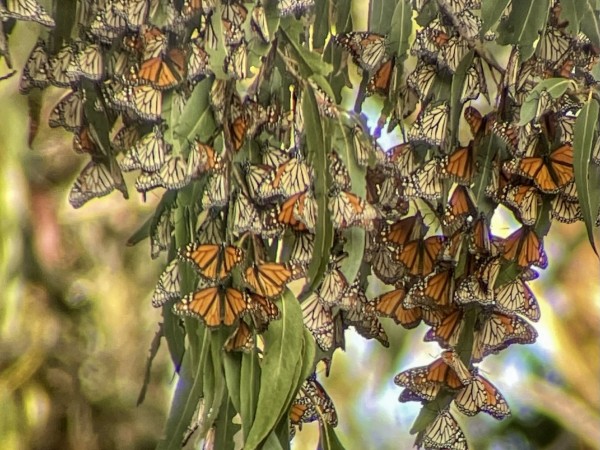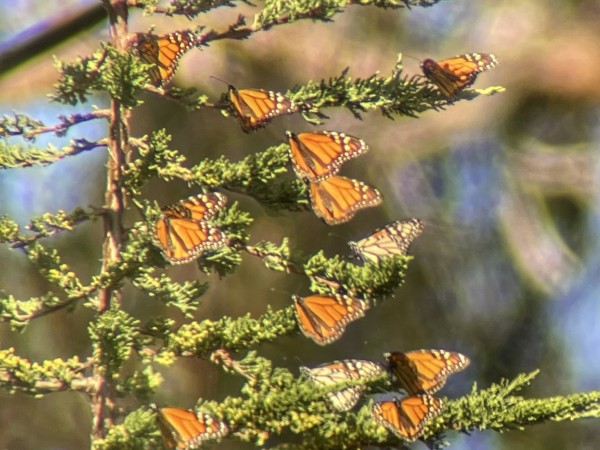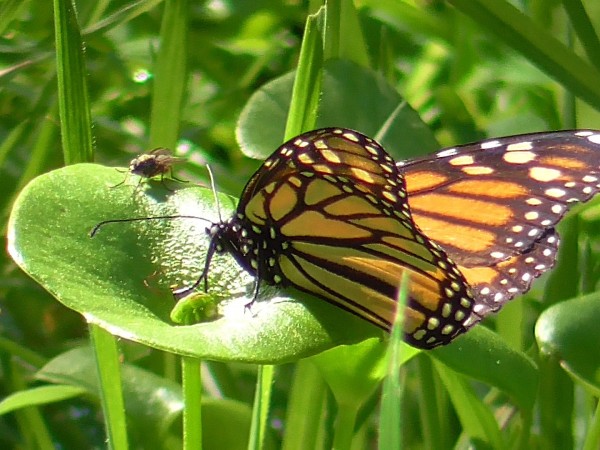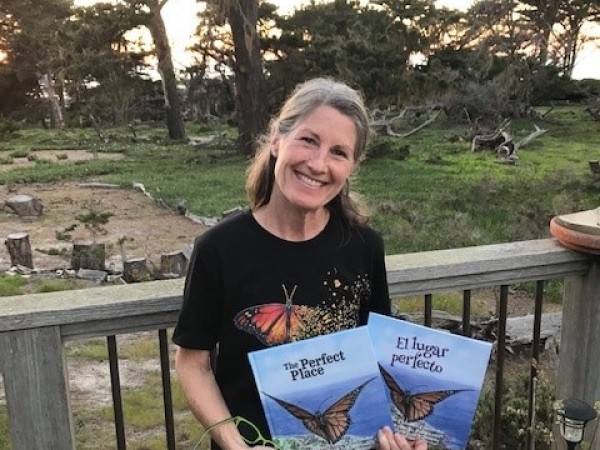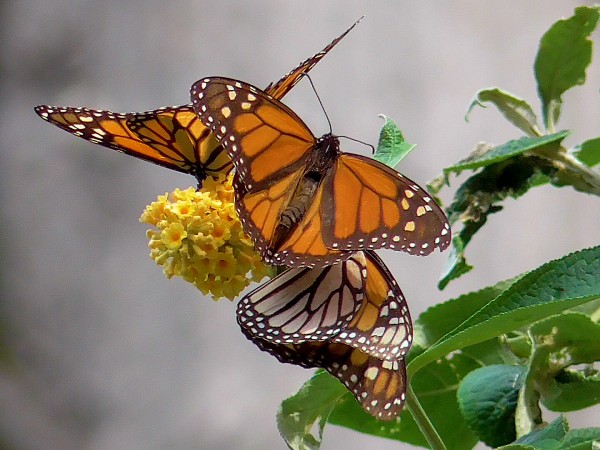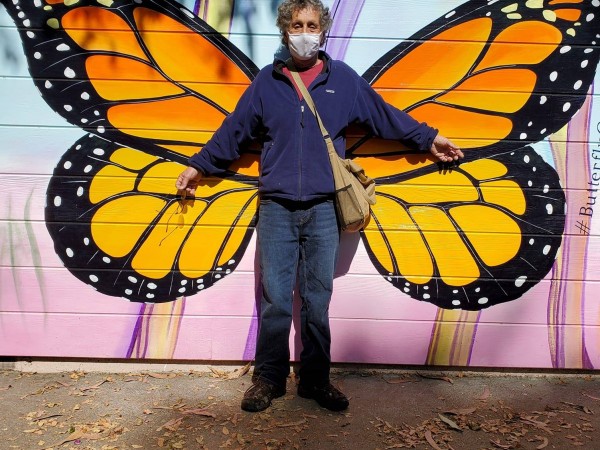Letter from Gail Morris: Western Monarch Winter 2021–22 Report #9
Published: 03/02/2022
Dear Western Monarch Friends,
Colder weather slowed monarch activity and sightings last week and some monarchs are still reported at the California overwintering sites. This is a good sign for the season since more milkweed will be up and ready for them when they do leave. In fact, the butterfly counts at Pacific Grove were even higher than the previous week. Arizona deserts are reporting monarchs as well. With warmer weather rolling in, look for monarchs flying your way. Keep your camera handy and be sure to report your sightings!
Western Monarch Sightings
Caterina in Pinole, California spotted her first monarch of the season on February 13. “Driving down Pinole Valley Rd west, I saw an adult fluttering across the busy road.”
James in Green Valley, Arizona, found one monarch on February 17. “La Posada, garden at Central Park, Green Valley, AZ. (1:50 pm - 3:20 pm) Temp. 57 degrees, wind 5 mph. full sun. One male Monarch observed flying through the garden and resting high up in Live Oak Trees (approx 20 ft high). All flights were high above the ground.”
Susan in El Segundo, California, reported 3 monarchs on February 22. “10:30 am Spring flowers starting to appear.”
Milkweed is up! Patricia in Oxnard, California, noticed milkweed breaking ground on February 15. “First perennial milkweed sprouted, Asclepias incarnata, Ice ballet.”
Notes from the California Overwintering Sites
Last week was cold enough to significantly slow the monarchs departure. Many locations are still reporting some monarchs along the coast.
Pismo Beach
Marylou Barker Gooden reports from the Monarch Grove at Pismo Beach. “On 2/21/22 the count at the Pismo Monarch Grove was 3,363. All of the clusters moved to the eastern part of the grove, adjacent to Hwy 1. The monarchs spend their time during the day sunning on the cypress and eucalyptus. Fewer mating pairs are observed each day.” Be sure to see her pictures!
Pacific Grove
Stephanie Turcotte shares an update about the monarchs at the Butterfly Grove in Pacific Grove.
Believe it or not, I am still able to report about monarchs in Pacific Grove, CA. Here is what we found to be the case yesterday morning, 2/25/22 when we counted.
This past week, all of CA was suddenly hit by a cold front, one which swept across the entire country. It was cold in Pacific Grove which meant that east of us, in the valleys, it was even colder and they had threats of freezing temperatures. Yesterday morning, just after sunrise, it was 34F in the interior of the grove. The extreme drop in temperatures most likely forced the monarchs lower down in the trees and into tighter clusters, in contrast to the previous warmer counts when the monarchs were higher up in the trees and dispersed throughout the canopies. Interestingly, there were NO monarchs in any of the Eucalyptus trees, which in the count a week earlier, had monarchs in many of them. The greatest concentration was in 3 Monterey Cypress and 2 Monterey Pines. Our numbers were higher than they were last week. We questioned whether it was because they were more densely clustered and we could get a better count. Or, did some of the monarchs that had already left return from the colder valleys or other sites? The final count for yesterday in Pacific Grove was 3,858!
Additionally, I had a group of 4-6th graders from an hour north of us in Palo Alto, CA visit the sanctuary yesterday. They sat on the ground for about 15-20 minutes and observed as a noticeably smaller male attempted to clasp onto an unwilling larger female. They noticed that both had damaged wings and that the male’s scales were in better condition than the female. They hypothesized why the female was resisting, abdomen visibly extended away from reach the entire time. They noticed the effort the male was putting forth and his refusal to give up. They noticed that the male would rest for a few seconds before continuing his efforts. They also noticed that it appeared to be quite brutal, at times, as the male pinned the female down to try and get the correct positioning. We weren’t sure how long the behavior would continue or what the outcome would be. The ‘Bowman Bees’ from Palo Alto, had to depart for home before finding out if the coupling was successful or not. We left small orange cones near the pair and we all walked away, as nature took its course.
Robert Pacelli shares photos of monarch clusters still at Pacific Grove’s Monarch Grove Butterfly Sanctuary and flying monarchs in the nearby neighborhood.
Santa Cruz
Diana Magor of Santa Cruz had a surprise this week. She found a monarch egg on potted milkweed she was growing in her backyard! “A monarch laid an egg on 2-20-22 on an A. cordifolia seedling I planted in 10” deep cells on 1-22-22 in Santa Cruz. Thought you might be interested. The colonies have dispersed and mostly departed, but some stay in Santa Cruz and other coastal areas, and apparently form resident populations. I have a nectar garden here and they visit almost daily.” Be sure to see her photo.
I’m experimenting with propagation of A. cordifolia (heartleaf milkweed) that breaks ground earlier than most of our common natives in California. Now that monarchs are mating and leaving their overwintering sites earlier than they used to due to climate change, we need to try to provide earlier emerging milkweeds for females to lay eggs on.
This species grows in the foothills and mountains of southern Oregon through Northern and Central California, but it is challenging to propagate. The other species that Cal Dept of Fish and Wildlife is propagating is California Milkweed, A. californica, which is the earliest rising of our Central and Southern California natives. A small group of milkweed enthusiasts and Monarch enthusiasts have set up a survey to study the phenology (timing) of 3 early rising milkweeds in the central Sierras and foothills to locate and follow the development of these species and determine where we could increase their abundance for the benefit of migrating Western Monarchs. If anyone is interested in the survey form, please contact dianamagor@icloud.com.
Thanks!
A special Thank You to Marylou Gooden, Stephanie Turcotte, Diana Magor and Robert Pacelli, for their expanded reports and photographs as well as everyone who submitted sightings and photos this week.
Winter Monarch Sightings Are Important!
Where are monarchs this winter? If you are seeing monarchs, be sure to report to Journey North whether they are adults or eggs or larvae. Provide as much information as you can such as weather conditions (it’s okay to estimate). Your detailed description of what you see can include, but is not limited to, the monarch’s gender and activity and, if known, the type of flowers if they are nectaring. If you can, observe the condition of the wings – are they fresh and new or worn and tattered or something in between – helps us learn more about monarch age and survival. We realize it isn’t always possible, but please take a photo if you can. Thanks so much for your help.
Gail Morris is the Coordinator of the Southwest Monarch Study (www.swmonarchs.org), a Monarch Watch Conservation Specialist, and the Vice President of the Monarch Butterfly Fund, the Central Arizona Butterfly Association and the Western Monarch Advocates. The Western Monarch Population News is based on comments provided to Gail Morris. We hope to increase the number of sightings and therefore photos and comments entered into Journey North. We rely on the volunteers who communicate regularly with Gail and who agree to participate in our effort to increase awareness of the population of western Monarchs. You can reach her at gail@swmonarchs.org

